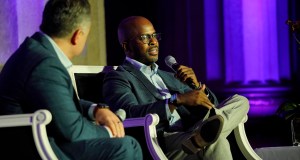Atlanta’s CIO lays groundwork for a smarter city

It’s been eight months since Samir Saini dove into his role as Atlanta’s chief information officer, but already he’s seeing the city’s IT future coming together – on a backbone built of fiber.
The former Atlanta Housing Authority CIO spent most of his first few months on the job streamlining and organizing the city’s information technology operations. But he also began laying the groundwork to make Atlanta a more connected city.
“We’re on that [smart city] path,” Saini told StateScoop during an interview in Atlanta late last month.
When Saini arrived, he found Atlanta’s IT operations were “very decentralized,” he said, prompting him to restructure the city’s Department of Information Technology. “We have fully stacked IT teams that all report into [our department]. Now, I’ll actually know what’s happening.”
The restructuring also enabled him to find areas of need. One of those needs led to the launch of what was dubbed the Fiber in Atlanta Services Team, or FAST, dedicated to expanding and more effectively managing the city’s use of fiber networks. That’s fundamental to enabling Atlanta to transition into a smart city later on, where real-time data promises to help city officials make smarter decisions about Atlanta’s infrastructure.
The team and the initiative are still in their early phases, “but they’re taking on municipal fiber projects on behalf of the various departments in the city, and handling it centrally while leveraging our existing fiber,” Saini said. “We’re getting more projects, and I think it’s key. Without that, we’re really never going to be a smart city.”
The Atlanta CIO said part of the city’s strategic plan calls for upgrading the city’s infrastructure to accommodate fiber-enabled devices. One idea could be to move city street lights to new, cheaper, more efficient LED lights that would be positioned in tandem with security cameras and other smart devices, all connected to fiber lines running from traffic light poles and along city streets.
“All of those sensors and devices need a fiber backbone,” Saini said. “The first thing that we did was assess what a municipal fiber picture looks like for the city.”
That assessment led Saini to discover additional opportunities to use the city’s existing fiber.
“We want to do something along the lines of what Austin and other cities have done,” Saini said. “We wanted to have a central fiber team that handles master planning, design, installation and maintenance for all the departments.”
With the establishment of FAST, Saini realized he would need the team to find ways to make smarter use of existing fiber currently used by state and city agencies and academia.
“Everyone’s got some fiber, and the reality is that no one’s fully using their strands,” Saini said. “If we collaborate, we could leverage and lease each other’s strands and it’s a win-win for all. That way, we can leverage the investment and really accelerate us becoming a smart city.”
While Saini’s team looks to find and use existing fiber for municipal use, his department is also evaluating the impact that upcoming infrastructure work coming from an infrastructure bond awarded to the city will have, alongside Google Fiber’s efforts to lay fiber optic Internet for the city’s residents. The way to handle that cluster of operations is not from a new smart city initiative, but rather through a tried-and-true platform in place in cities across the country.
“It’s almost the perfect storm. We have every street getting ripped up, and how do we coordinate the activity of what Google is doing and what we’re doing internally across departments?” Saini said.
One answer, he said, is to take greater advantage of the city’s new geographic information system launched late last year in response to the city’s snowstorms in the winter of 2013. The system is expected improve planning and help better manage road activity in the midst of infrastructure improvements and Google Fiber operations.
“If we do nothing, we’re going to be stepping on each other’s toes,” Saini said. “We need to see all of it on the map and coordinate our activity from planning to execution.”
But Saini has his eyes on a bigger IT vision for Atlanta – delivering on three priorities: reliability and security, efficiency and effectiveness, and citizen services.
“If we don’t address the backbone, innovation is meaningless. It’s not possible,” Saini said. “Solutions are solutions, they’re just tools. They’re technologies, applications, whatever, but the alignment of the technology to the process — that’s innovation. That’s an innovative way of doing something.”
In his role, Saini doesn’t necessarily see himself as the gatekeeper of Atlanta’s technology and networks, but rather as the person who connects process and technology to create tools that benefit the government, as well as its citizens.
“Innovative technology doesn’t actually mean anything, whether it’s being used to its full capacity to drive benefits and outcomes for the city is a whole other matter,” Saini said.






